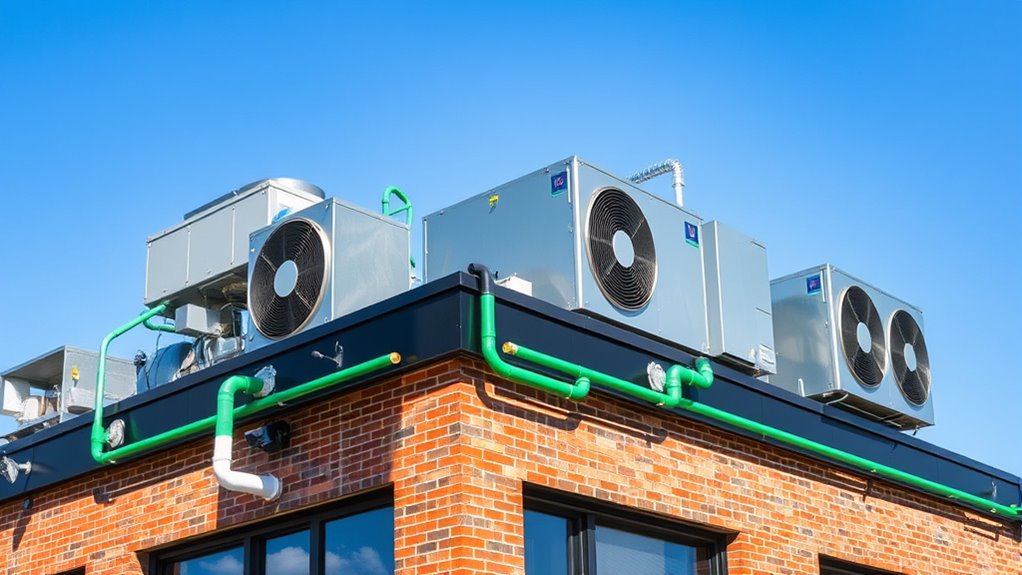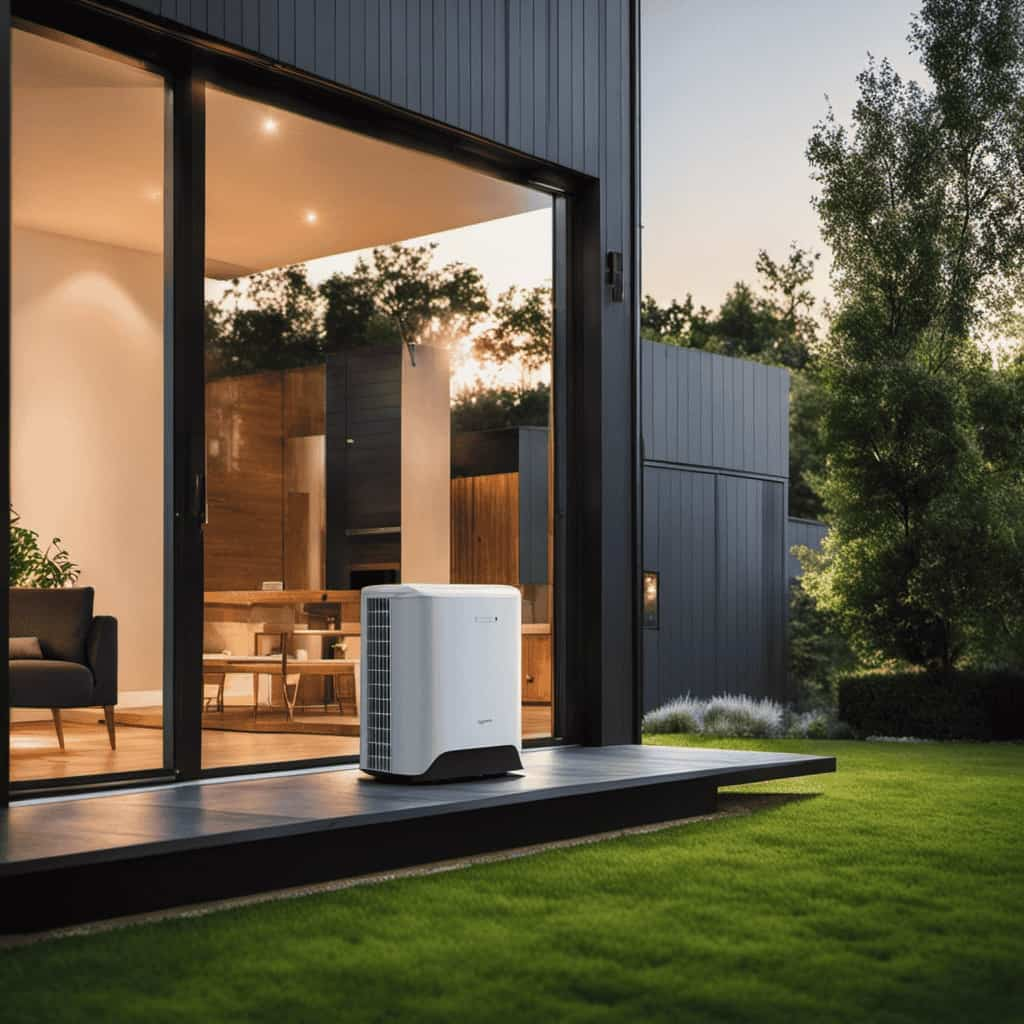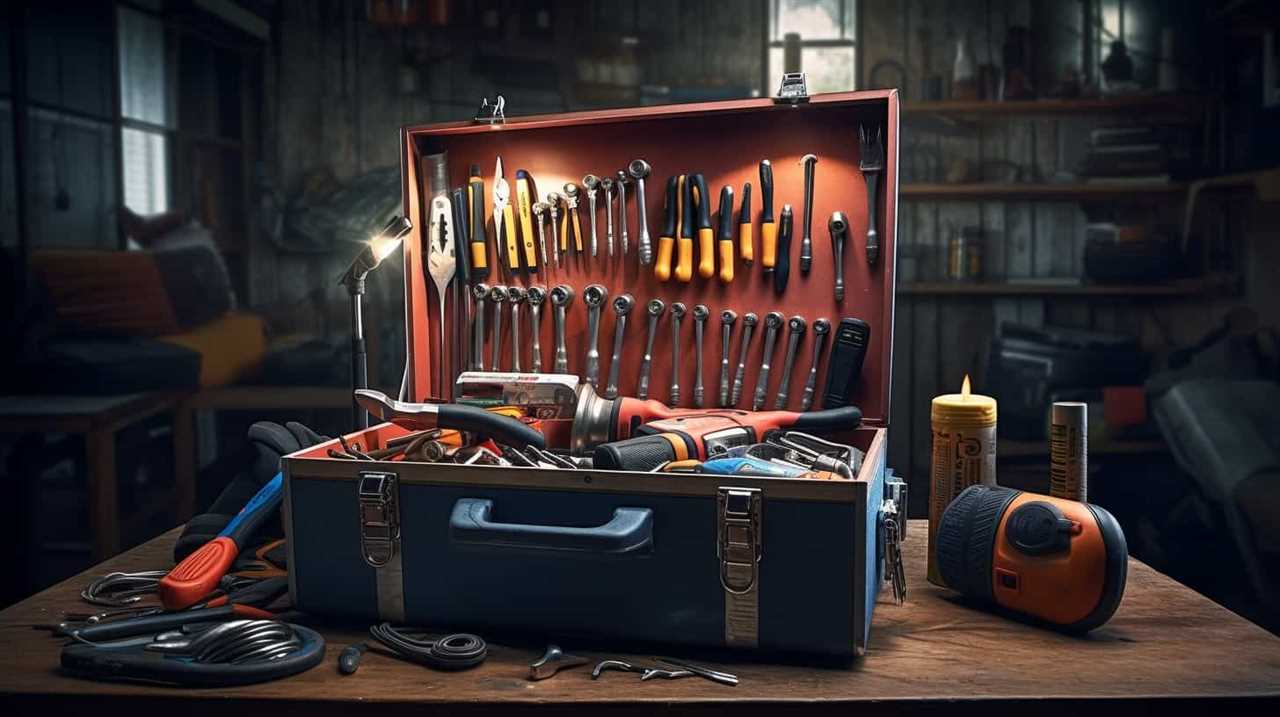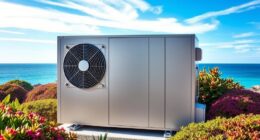Retrofitting your commercial building with heat pumps can greatly boost energy efficiency, cut emissions, and lower long-term costs. By evaluating your current infrastructure and choosing compatible units, you can overcome initial challenges like pipework modifications and system upgrades. Utilizing available incentives and planning carefully helps minimize disruptions and costs. Advanced technologies like renewable integrations ensure your building stays sustainable and future-proof. Keep exploring to discover how to optimize your retrofit for maximum benefit.
Key Takeaways
- Conduct comprehensive site assessments, including heat loss calculations and infrastructure evaluations, to determine retrofit feasibility.
- Ensure existing pipework, radiators, and electrical systems are compatible with low-temperature heat pump operation.
- Plan for potential structural modifications and disruptions, especially when upgrading pipe diameters or electrical wiring.
- Leverage financial incentives like grants and tax allowances to improve economic viability and reduce retrofit costs.
- Integrate renewable energy sources and smart controls to maximize energy efficiency and support long-term sustainability goals.
Understanding the Benefits of Heat Pump Retrofits
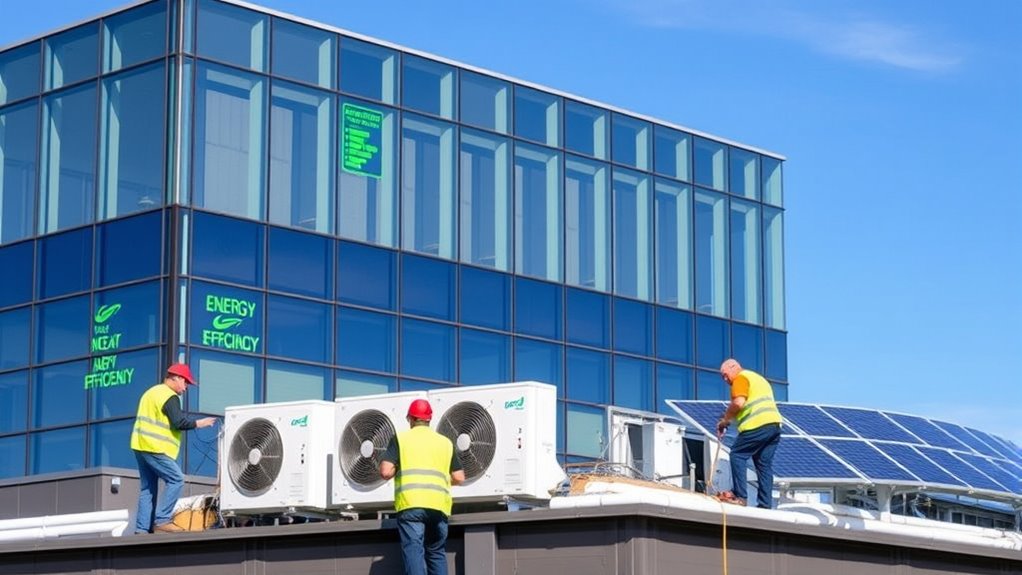
Retrofitting your commercial building with heat pumps offers a clear path to reducing emissions and improving energy efficiency. Heat pump retrofits replace fossil fuel-based systems with energy-efficient electric alternatives that markedly lower building emissions. Modern heat pumps deliver high COPs, producing three to five times more heat energy than the electricity they consume, enhancing operational efficiency. Using renewable energy sources with these systems boosts sustainability and supports your climate goals. Upgrading existing buildings with heat pumps not only cuts carbon reduction efforts but also extends system lifespan to 15–20 years, ensuring long-term value. Despite higher electricity costs, energy cost savings are achievable, especially when paired with renewable energy. Overall, these retrofits help you meet environmental targets while optimizing operational performance.
Assessing Building Compatibility for Heat Pump Installation
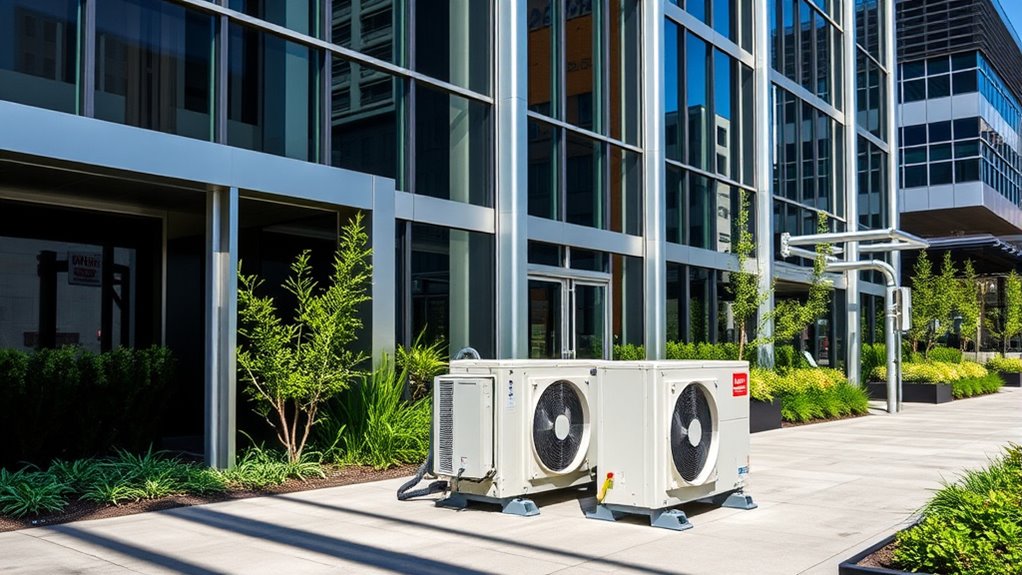
Before installing a heat pump, evaluating whether your building is compatible with this technology is vital. You’ll start with heat loss calculations to determine the system’s proper sizing and guarantee your building’s insulation keeps heat demand manageable. Existing pipework and retrofit infrastructure often remain useful, especially when refrigerant compatibility matches boiler temperature differentials, simplifying installation. Assess whether your heating emitters, like radiators, can handle the new system—some may need resizing. Check available outdoor space for outdoor units and consider how system design will integrate with your current setup. Compatibility depends on refrigerant type, building insulation, and heating demand. Proper assessment ensures a smooth retrofit, minimizes disruption, and guarantees your heat pump system functions efficiently and effectively. Additionally, conducting a comprehensive system compatibility assessment ensures all technical aspects align for a successful upgrade. Regular maintenance and inspections are essential to keep the system operating at peak efficiency over time. A thorough evaluation of building energy efficiency can also help identify potential improvements that enhance overall performance and longevity of the heat pump system. Ensuring the building’s existing insulation levels meet the requirements for heat pump operation can significantly impact the system’s overall efficiency and effectiveness, especially when combined with best practices in system design.
Overcoming Challenges in Retrofitting Existing Systems
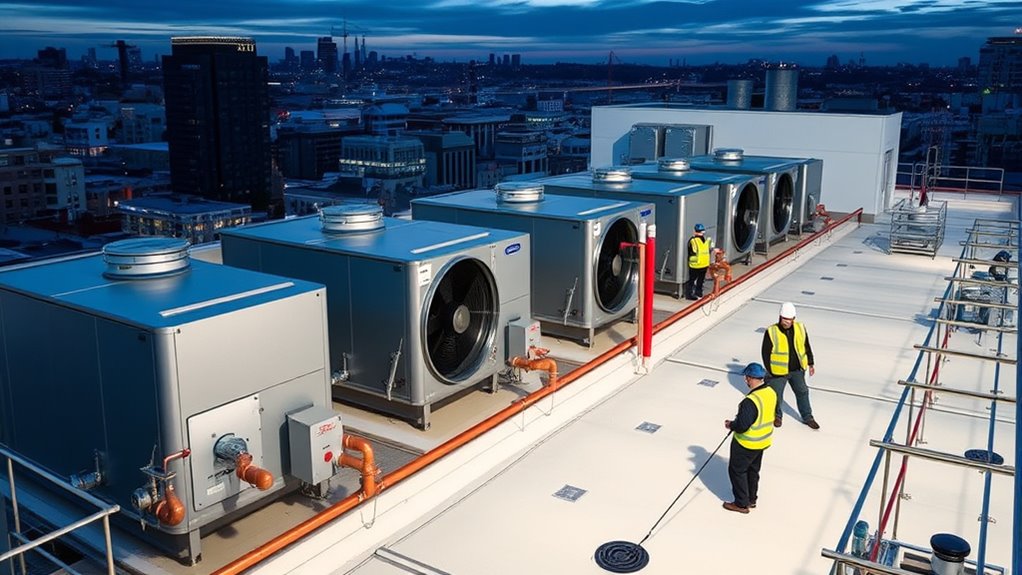
Retrofitting existing systems with heat pumps presents challenges like infrastructure compatibility and potential costs. You need to carefully assess your building’s current setup to minimize disruptions and guarantee efficiency. Addressing these issues early on helps you achieve a smoother transition and long-term savings. Additionally, understanding the energy efficiency benefits of heat pumps can help justify the investment and optimize your retrofit process. Recognizing how system compatibility impacts installation can prevent unexpected delays and expenses. Conducting a detailed system evaluation can further identify potential upgrades needed for seamless integration. Incorporating deliberate planning can also improve the overall success of the retrofit by ensuring all components work harmoniously, which is essential for fostering creative problem-solving during complex retrofit projects.
Infrastructure Compatibility Issues
While upgrading existing commercial heating systems with heat pumps offers cost savings and less disruption, ensuring infrastructure compatibility remains a key challenge. Compatibility depends heavily on refrigerant types; using refrigerants like R290 simplifies integration with existing pipework and heat emitters. Older radiators and emitters may require resizing or replacement to perform efficiently with low-temperature operation. Conducting a thorough retrofit assessment, including accurate heat loss calculation, helps determine if your current piping infrastructure can support the new system. Reusing existing pipework and emitters is often feasible, but careful evaluation of refrigerant compatibility and radiator capacity is essential. A bespoke system design may be necessary to address specific infrastructure limitations, ensuring a seamless infrastructure retrofit and ideal performance of your heat pump system. Additionally, understanding the types of heat emitters and their compatibility with low-temperature heat sources is crucial for a successful retrofit. Incorporating building heating requirements into the planning process ensures the system meets specific needs and maximizes efficiency. Considering the existing infrastructure and its compatibility with modern heat pump technology can prevent costly modifications later on. For example, verifying the compatibility of refrigerants with existing pipework and heat emitters can significantly influence the retrofit’s success. Considering the lifestyle of building occupants can also influence system design choices to enhance comfort and usability.
Cost and Disruption Factors
Retrofitting commercial buildings with heat pumps involves considerable costs and potential disruption, which can pose significant challenges. You’ll face retrofitting costs ranging from $12 to $24 per square foot, influenced by infrastructure modifications and system complexity. Disruption often occurs during pipework upgrades or electrical system reconfiguration, especially in occupied spaces. Upgrading water temperatures may require pipe diameter enlargements, leading to structural modifications. The need for pipework upgrades, system reconfiguration, and infrastructure modifications can prolong installation times, affecting occupant comfort and operations. Additionally, low light office plants can improve indoor air quality and occupant well-being during renovation periods. Proper planning and coordination can help mitigate installation delays and reduce overall disruption. Understanding the evolution of heat pump technology can also assist in selecting the most efficient solutions for retrofitting projects. Incorporating sustainable practices and energy-efficient equipment can further enhance the long-term benefits of the retrofit.
Planning and Executing a Successful Retrofit Project
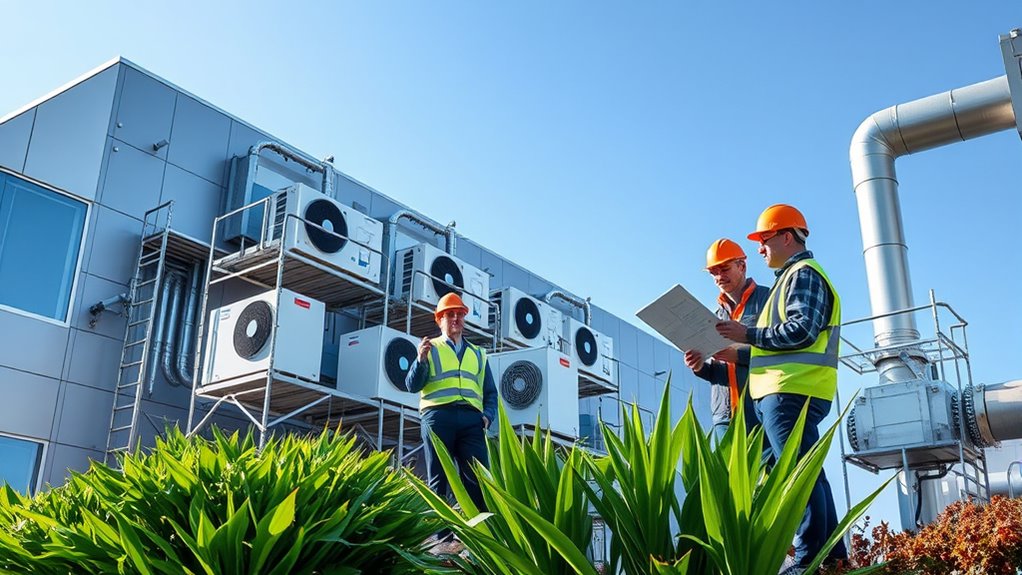
To guarantee your retrofit project succeeds, start with a detailed site assessment and customized design that considers existing infrastructure and energy needs. Manage costs and minimize disruption by planning installation carefully and coordinating with experts throughout the process. Additionally, leveraging industry trends can help identify the most efficient heat pump systems for your building. Incorporating energy efficiency strategies can further optimize the retrofit’s long-term benefits. Staying informed about trailer music insights can also inspire innovative approaches to system integration and soundproofing solutions. Conducting thorough testing and system integration ensures optimal performance, which is essential for achieving long-term savings and energy efficiency. Incorporating refrigeration cycle principles into system design can optimize heat transfer efficiency and overall performance. Finally, thoroughly test and integrate the system to assure peak performance and long-term savings.
Site Assessment and Design
Effective site evaluation and design are crucial steps to guarantee a successful heat pump retrofit in commercial buildings. Start with a thorough site review to examine existing infrastructure, including pipework and radiators, confirming compatibility and identifying needed modifications. Conduct heat loss calculations and energy audits to determine accurate load requirements, guiding proper system design and sizing. Use performance modeling to optimize energy efficiency and long-term savings. Develop a retrofit plan that minimizes disruption by considering space needs and electrical upgrades. Key considerations include:
- Analyzing existing infrastructure for compatibility
- Performing heat loss calculations and energy audits
- Planning electrical upgrades and system design
- Ensuring retrofit plan minimizes occupant impact
- Incorporating appropriate projector technology considerations to support presentations, training, or digital displays as part of the retrofit plan. Additionally, understanding the power requirements of new HVAC components ensures seamless integration with existing electrical systems. This extensive approach ensures your retrofit is efficient, effective, and compliant.
Cost and Disruption Management
Careful planning is essential to manage costs and minimize disruptions during a commercial heat pump retrofit. Conducting thorough energy audits helps you identify cost-effective retrofit work and avoid unexpected expenses. Engaging retrofit professionals ensures proper system design, reducing installation costs and preventing errors. Scheduling retrofit work during tenant turnover or low-occupancy periods minimizes occupant impact and disruption management issues. Choosing refrigerants like R290 or CO₂ can simplify installation and limit system disruption. Implementing phased upgrades or modular retrofits allows you to spread costs over time and reduce operational downtime. This approach provides flexibility, manages occupant impact, and helps keep your project within budget. Incorporating sound healing science concepts during planning can also promote a more positive environment for tenants and staff. Proper planning and execution ensure a smooth retrofit, maximizing performance gains while minimizing inconvenience.
System Integration and Testing
Successful system integration begins with precise heat loss calculations and a bespoke design that aligns with your existing building infrastructure. This foundation guarantees compatibility and smooth operation during the retrofit process. Focus on thorough testing, including radiator performance checks by lowering boiler temperatures to 60°C, to verify suitability for low-temperature heat pumps. Proper installation sequencing minimizes disruption and guarantees seamless system compatibility. During commissioning, verify efficiency and performance, confirming that the new system works harmoniously with existing emitters. Effective planning and detailed testing help identify potential issues early, reducing costly adjustments later. Ultimately, a well-executed system integration and testing phase ensures your retrofit delivers maximum energy savings and reliable operation.
- Accurate heat loss calculations inform design choices.
- Testing radiator performance validates low-temperature operation.
- Installation sequencing minimizes downtime.
- Commissioning confirms system efficiency and compatibility.
Economic Considerations and Available Incentives
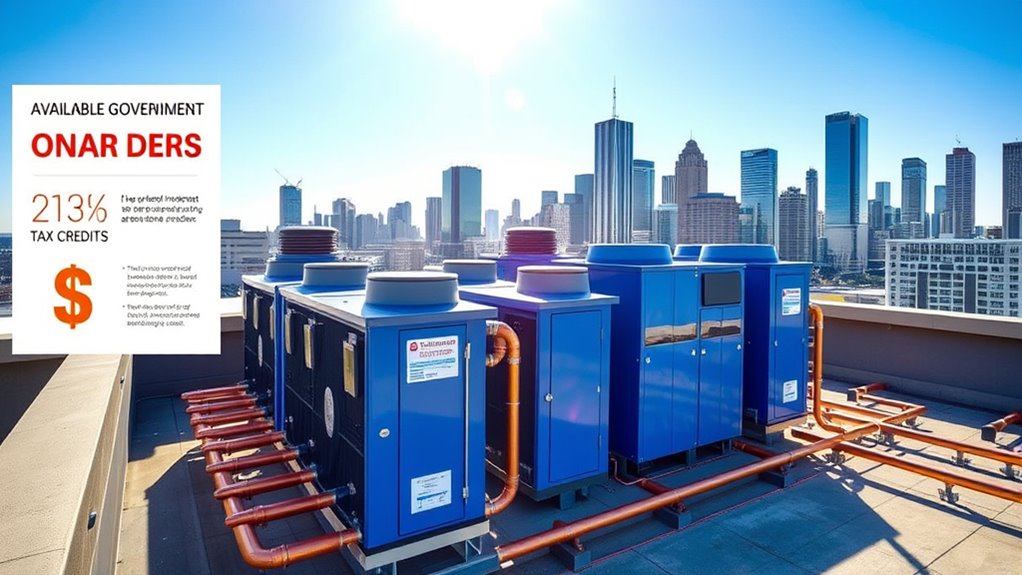
Considering the high upfront costs of retrofitting commercial buildings with heat pumps, understanding available financial incentives is essential. These incentives, including rebates, grants like the Clean Heat Grant, and the 50% first-year allowance, can make the project more cost-effective by offsetting initial retrofitting costs. By leveraging these financial incentives, you improve the economic viability of your retrofit. Thoughtful system design, combined with demand management and renewable integrations such as rooftop solar, further enhances ROI and shortens the payback period. Many industry estimates suggest that combining incentives with efficient system planning can substantially reduce costs and boost long-term financial returns. This approach ensures that your retrofit remains financially sound while advancing your sustainability goals.
Future-Proofing Commercial Properties With Advanced Technologies
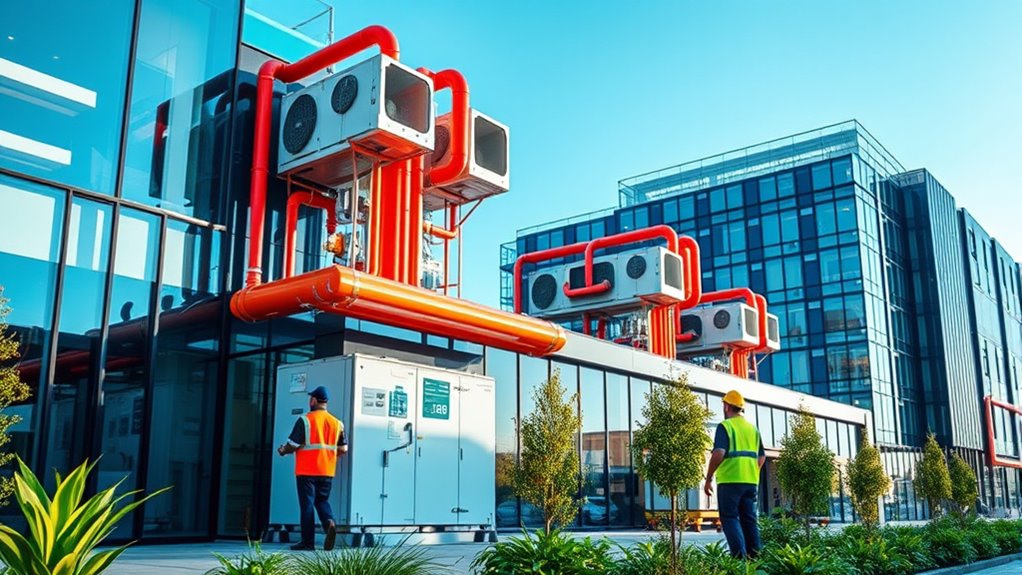
To future-proof your commercial property, integrating advanced heat pump technologies is essential. Retrofitting heat pumps with smart controls and demand response capabilities ensures your building adapts to evolving energy grids and decarbonization policies. High-efficiency heat pumps paired with renewable energy sources like rooftop solar and battery storage help achieve net zero emissions and reduce energy costs over time. Incorporating hybrid heat systems and modular designs allows your commercial retrofit to stay resilient against technological obsolescence. Natural refrigerant heat pumps, such as R290 models, align with future regulations and safeguard your investment. These strategies create a future-proof building that maximizes energy efficiency, supports building electrification, and remains competitive in a rapidly changing energy landscape.
- Enhance long-term value with sustainable, adaptable systems
- Reduce regulatory risks through compliant, eco-friendly technologies
- Increase resilience with flexible, hybrid solutions
- Maximize renewable energy integration for cost savings
Frequently Asked Questions
Are Heat Pumps Good for Commercial Buildings?
You might wonder if heat pumps are suitable for your commercial building. They’re highly efficient, providing both heating and cooling with 3 to 5 times the energy savings of traditional systems. Plus, they can be integrated smoothly into existing setups, especially with natural refrigerants. With a lifespan of 15-20 years and significant carbon reduction benefits, heat pumps are a smart, sustainable choice for your building’s long-term operation.
Is It Worth Retrofitting a Heat Pump?
You’re wondering if it’s worth retrofitting with a heat pump. Consider that heat pumps can deliver COP values of 3 to 5, meaning you get 3 to 5 times the energy you put in. While upfront costs range from $12 to $24 per square foot, energy savings and incentives like tax credits make the investment worthwhile over time. Plus, natural refrigerant options boost sustainability, adding long-term value.
Why Don’t Contractors Like Heat Pumps?
You might wonder why contractors hesitate to install heat pumps. They often lack training and familiarity with the technology, making them cautious. Upfront costs and the complexity of retrofitting older buildings also deter them. Supply chain issues and limited model availability add to the challenge. Additionally, concerns about building compatibility, occupant acceptance, and maneuvering regulations make contractors hesitant to recommend heat pumps.
What Is the Most Efficient Way to Heat a Commercial Building?
To truly transform your heating, focus on fitting your building with high-efficiency heat pumps paired with proper insulation. This duo delivers dynamic, dependable warmth while minimizing energy use. Opt for air source heat pumps with natural refrigerants, and consider integrating renewable resources like solar. By blending robust retrofits with radiant renewables, you create a cost-effective, clean, and consistent climate control system that maximizes efficiency and minimizes costs.
Conclusion
Think of retrofitting your building with heat pumps like upgrading from a bicycle to a motorcycle—you’ll move faster, more efficiently, and with less effort. A recent study shows that commercial retrofits can cut energy costs by up to 30%. Just like tuning a car for peak performance, your investment in heat pumps boosts comfort, reduces emissions, and future-proofs your property. Embrace this change, and watch your building run smoother and smarter for years to come.
